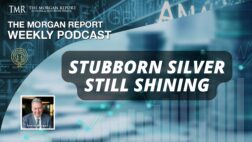This week’s Market Wrap Podcast with Mike Gleason and David Morgan.
David gives us a sneak peak about what to expect in the gold and silver markets this year, and the likelihood gold and silver will reassert themselves as money in the face of a potential global currency collapse.
## Transcript ##
Mike Gleason: I’m happy to welcome back our friend David Morgan of the Morgan Report and
www.Silver-Investor.com. David since we haven’t gotten together since last fall, I guess a belated happy New Year. It’s good to talk to you again. How are you?
David Morgan: I’m doing well, thank you Mike.
Mike Gleason: Let’s get right to it today because we’ve got a lot of things to cover as usual. First off, we’ve had a very positive start of the year for gold and silver. Although the metals are getting hit pretty hard today as we’re talking here on Thursday afternoon. What do you make of the market action so far this year and especially this pull back that we’re seeing today…that I understand had mostly to do with them raising margin requirements, is that it?
David Morgan: That certainly plays into it quite a bit. Constructive is the word I would use. It’s been constructive, I think the lows are in finally for both gold and silver. The end of last year we had a spike low in silver. One that was similar in gold. And we’ve been building up from there. Not ignoring today’s action with silver off a dollar and gold off $25, but that’s constructive really. Meaning that all markets go up and down. Regardless of the cause of manipulation. Margin requirements increases. Good news, bad news on the general economy, et cetera.
The trend has been up. It’s been strong. The volume has started to look pretty decent. So I think we’re going to have a better year, this year than we had for the last three years and gold in the last four or so.
It’s not going to be a barn burning year in my view, but it’ll be a constructive view with higher prices.
Mike Gleason: Last time we spoke you had mentioned the mining industry was taking a terrible beating given the prolong period of low spot prices in the futures markets. Now obviously you report on a handful of companies that are still doing well, but most you said are really struggling and they’re scaling back production or even going out of business altogether. What’s the latest there?
David Morgan: Well to back up, and you’re correct in what you said, but The Morgan Report did an analysis on all the companies we profile currently. The top tier, mid tier, and speculative section. Now we picked two, or found the two best in each category. Before like, ultra conservative investors, moderate conservative investors, speculators, and most investors sprinkle their portfolio with all three sections and we found the most undervalued companies, a couple of those in the top tier are up 30 to 40% from when we pull out the report for the January issue are still off today with the sell off in the metals today. But the real value is really there, but I don’t want to say anything that isn’t consistent of what I’ve said for many years and that is really starting a portfolio you have to have the (physical) precious metals first.
But in a way if you want to catch up to the people that were able to buy silver at $5 and gold at $200 or $300…the way to do that is to find the right mining companies today at very, very under-valued positions and buy into them and certainly you have to buy more than one for lots of reasons. But a good core holding of even like 6 companies would be something that have a lot of leverage to the metal.
So, the company going out of business, et cetera, that still is unstable. Many of these companies that were in the junior category are out of business. The ones that are hanging on many of them moved offices, 2 or 3 companies are in one office and they share the secretary expenses that way. These companies are in Vancouver, which is the resource capital of the world, they certainly, have been through hard times before. They know how to ebb and flow with market conditions. Most of them, they’re viable. They’ll do anything that they possibly can to stay in business.
Some of them are good prospects or proven them enough to maybe less risky than others, let’s say. They can be M&A’ed, a merger and acquisition type of network or something else. Still plenty to look forward to in the mining sector from the junior space all the way up to the top tier producers. But the field is getting narrowed.
The problem with these gold and silver companies is that, for the average company we’re right near the cost of production still. Gold is somewhere, and it varies from company to company, but the rule of thumb around the $1,450 level (in gold), silver somewhere around the $20 level, all-in costs of course and we’re below those levels. These companies can’t go on forever at those prices but they certainly will operate for quite some time.
Mike Gleason: Kind of staying on that topic here with the mining industry and cost of production so forth. I want to ask you about some of the figures you put out on true all in cost of silver production. I think you recently reported that for some it’s closer to $24, which is higher than I’ve seen some other people report. Talk about the reasons how you came up with that number. Some have put $15 to $20 as sort of an average all in cost of production, but you’ve factored the whole picture there, don’t you?
David Morgan: Right, and first of all, you have to set up the parameters. What are the givens? The givens are we’re looking at only primary silver producers. We’re not looking at big conglomerates like BHP, or RTZ, or one of these multi-national companies that mine base levels and silver is a credit to them. So, we’re talking about companies that make their living by mining silver. That would mean at least 50% or more, revenue is the bottom line is due to silver mining.
There is no such thing as a pure silver mine. First Majestic, Tahoe Resources, Endeavor Silver, US Silver, Helca Mining, Coeur d’Alene, you name it. They all mine silver but they mine lead, zinc, and copper or some variation thereof throughout the industry. So there’s no such thing as a mine, only mine silver only. Although First Majestic is pretty close with about 90% exposure to silver.
Regardless, you have to look at those companies and that’s a handful. I mean, you can put it along your two hands and have some fingers left over. Then you got to look at all the costs and we do the analysis. But the one thing that most leave out in the all-in costs, some of our friends in the business, is the tax situation.
A lot of these companies have a carry loss that they can take advantage of and that’s good for the years that they have a loss when situations like we’re currently in, where they’re mining at a loss and they take a loss against production and it helps them from an overall cost standpoint for that year or a few years.
Now the years that they’re making money. When silver was at $30 an ounce, their cost are $24 let’s say, obviously they that tax base. We look at that cost as well, since it is a true cost. We realize it’s not an every year thing. But one thing I’ll say is that we came in with about $22, I mean it varies again from company to company. But what I say is that that number may be a bit high now Mike, because when we did the last analysis so we can update it and make dropped to $20.
About 25% of the cost on a fully operating mine, and again this is a rule of thumb, it isn’t every mine is energy. Since we’ve seen such a drastic drop in the price of oil, the cost, the true all-in costs are going to be less, not more. Because that’s a huge part of the budget, it’s dropped substantially.
Are my numbers high? Yes, they are right now. But you know, all you can do is all you can do. With the absolute factual information at the time. Does it vary? Sure it varies. How much does it cost to heat your house, or run your car, or whatever? It’s different now than what it was 6 months ago.
Mike Gleason: Gold and silver have held up pretty well while oil was of course taken a major hit here. Is that surprise you at all?
David Morgan: It’s not a big surprise to me, and the reason being is that having studied this sector for so long and also having lived through one major market in the past in the metals as well as a couple of bull markets in the stock markets…we have observed that when we get near the end game, meaning where gold asserts itself of the ultimate currency against everything else. You will see the dollar going up – which is probably the most perceived safe haven investment that there is – going higher against all other currencies and at the same time gold going up a long with it.
This is contrary to a lot of thinking because there’s a lot of my peers that basically make the case that they’re inversely related. You know, gold up, dollar down, dollar up, gold down. So it’s an inverse relationship. That’s true for a great deal of the time.
Then again, near the end game what happens is you’ll get into what’s called a liquidity squeeze. People seek the most safe asset as they can. There’s nothing safer than cash except real cash and that’s precious metals. But only one, or two, or three percent of the population ever act on that knowledge. They know that only 5% even understand it or understand why did they have any exposure to it. Meaning, a grandson of somebody, a granddaughter of somebody that lived through a situation like the Weimar Republic. They’ve heard from their grandparents, or great grandparents, or fathers’ mother, that told story about their grandparents.
You have to experience during a hyperinflationary depression or more recently if you’re in Argentina. What’s happen there a few times recently … All these currency crisis that happen. People in Zimbabwe. I’ve done a video that is on the net. You could probably go to YouTube and search David Morgan and hyperinflation. But when that Zimbabwe dollar was about equivalent to the US dollar at one point. They had teachers that were retired making 30,000 Zimbabwe dollars a year. That was there retirement. At the time it was you know, it was enough, it wasn’t luxury living but it was enough to be retired.
Think of what happened to them. Now I’m not predicting hyperinflation, butthat doesn’t mean we can’t see the currency depreciate even further where it is detrimental to almost everybody. That is what I expect.
That means that there is a lot of people that will be moving in the gold market over time. There will be a point at some time, probably 2016 where that accelerates. Where people that are holding cash realize, geez I don’t want dollars…they are not as valuable or there’s too much problem with this currencies market or whatever. It could be multiple number of reasons, primarily it be depreciation of currency and moving into gold.
We’re going to see gold moving against the dollar. Which is doing now and I say, let’s go into the gold market. So if you see a choppy market here for the gold and silver, I think. But again constructive. Mostly up and I think the key levels we’re looking for is $26 in silver and $1,550 in gold. I think it will be achieved this year, but I’m not going to stick my whole reputation on it. What I do know is we’re far, far from the ultimate high in these markets. These markets did accelerate a few years back and that’s a taste of what’s to come. That is, just again, a taste of what I see in the future, because in the future it’s going to be, probably the kind of move in the metals markets that is going to go into the financial history books.
Mike Gleason: We seem to have a lot of fireworks brewing here in the currency world. You just mentioned hyperinflation a moment ago. Maybe we are starting to see the beginning of some sort of an end game developing here. The Swiss decided we’re going to unpeg the franc to the euro. A lot of the euro money is flowing into precious metals. What do you make of everything that’s going on there and then gold and silver re-asserting themselves as the true currency.
David Morgan: Absolutely. This is something that I’ve been forecasting, along with others, for a very long time. Because the ultimate game for the end game is a currency war. And it started with the oil situation and that brought (Russian) ruble to its knees. Then the Swiss said well Draghi is going to open the flood gates to money printing and they know what happens. So they exited themselves from euro peg so they wouldn’t be taking down with the ship in this hyperinflationary, or let me see inflationary mode that the euro is going to keep printing. So they exited that peg.
I’m addressing that in the latest Morgan Report that is going to go out this weekend. I don’t want to give away the farm. I’m certainly not an original thinker, all though somewhat be. There’s a question about that that I’ve got the attention of our subscribers that I think is full of the most important questions you can ask about these currency wars. If you very astute and you can read between the lines, they understand what I’m eluding too.
But that is Mike. All these things are coming together where you see who’s currency … Wild currency fluctuates. Wild, I mean look what happened to ruble. Look what happened to Swiss bank. Look what’s going on in the euro market. Look what’s happening in the dollar. Then you start scratching your head and gold is going up against all of them. Why is that?
So, all these things are starting play out pretty much how I would have expected them, if you would’ve asked me on which end game looked like 10 years ago. I say well, near the end, wild currency fluctuations. A lot less trust in the system. A lot of volatility that’s off the charts. Today we get the yen trade for example to kind of move you used to get over a year’s time back in the currency markets.
I never traded currencies often. I did a few, I did some, not a lot. But I did some yen versus dollar. I was pretty good at it, but I know from my trading days, when I was trading metals, but where, like I said, the move that you see now, in a matter of weeks is definitely (volatile) … It (used to) take a year to get those kind of percentage.
So things are accelerating, and changing, and causing people to wake up to the fact that something is not right in the financial section. Something is not right in the currency system, the geopolitical situation is obvious if you pick up anything from the mainstream press and or alternative media. So this just leads more and more to people that want what we all want and that’s certainty. They are going to rush to something that’s certain. There’s nothing more certain then something that’s been money for thousands of years. None of these currencies have lasted more than 200 years.
Mike Gleason: That’s certainly a key point and obviously we are seeing some big moves in a lot of volatility in these markets and that could be a foreshadowing of some major things to come. Well excellent insights as usual David. I know you’re a busy guy. Thanks again for always being so generous with your time and I look forward to catching up with you again real soon.
David Morgan: Thank you so much.
Mike Gleason: Well that will do for this week, thanks again to David Morgan. Publisher of The Morgan Report. As we’ve done in the past, we’re offering free Silver Eagle bonuses for anyone who signs up for risk-free trial of your newsletter. Our listeners can access this special offer from this week’s podcast playback page at moneymetals.com.
David Morgan is a precious metals aficionado armed with degrees in finance and economics as well as engineering, he created the Silver-Investor.com website and originated The Morgan Report, a monthly that covers economic news, overall financial health of the global economy, currency problems, and the key reasons for investing in precious metals.
As publisher of The Morgan Report, he has appeared on CNBC, Fox Business, and BNN in Canada. He has been interviewed by The Wall Street Journal, Futures Magazine, The Gold Report and numerous other publications. If there is only one thing to teach you about this silver bull market it is this… 90% of the move comes in the last 10% of the time! Where will you be when this happens?
Offer does not apply to Premium Memberships.



